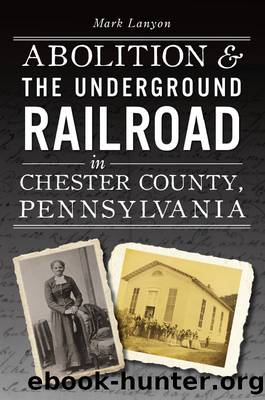Abolition & the Underground Railroad in Chester County, Pennsylvania by Mark Lanyon

Author:Mark Lanyon
Language: eng
Format: epub
Publisher: The History Press
Published: 2022-09-15T00:00:00+00:00
The Longwood Progressive Friends Meetinghouse was home to Quaker abolitionists who believed actions not words were needed to end slavery. Courtesy of the Chester County History Center.
The Kennett Square Anti-Slavery Society was very active, even before LPFM came into existence. On May 12, 1838, the society issued a âStatement of Purpose of the Kennett Abolitionists,â which read:
Resolved,
That we recommend to our southern brethren that the most effectual and expeditious way of putting down abolition at the North is to put it up at the South, by breaking the fetters of the captives, and letting the oppressed go free.
Resolved,
That in the potency of the principles, which, as abolitionists, we have embraced, and in the evidences of the advancement of the cause of universal emancipation which throng upon us, we find abundant encouragement to persevere in our labors, for down-trodden humanity, and much reason to hope that our efforts, under God, will be crowned with entire success.
Resolved,
That any person who aids in restoring the fugitive to his master and in reimposing the chains of slavery upon a fellow being, whether acting as a public officer or otherwise, are guilty of a crime against freedom, humanity, and religion, and should be regarded as the abettor of a huge and cruel disposition.
Resolved,
That those professed ministers of the gospel, who attempt to justify or palliate the system of American slavery from the scriptures of the Old and New Testaments, are doing more to bring the Bible into disrepute and undermine the faith built upon its glorious truths, than all the avowed and open opponents of Christianity within our land, and we are compelled to look upon them, whatever may be their profession, as in reality the enemies of the religion they profess to love.
âChandler Darlington, secây197
At that time, the secretary of the society was Chandler Darlington, and the president was John Cox, both of whom were founding members of LPFM fifteen years later.198 The antislavery sentiment was heating up, as shown by the powerful statement released by the Kennett Square Anti-Slavery Society. This document was so important that it was included in the program for the 150th Anniversary Celebration of the Longwood Progressive Friends Meeting, held on Sunday, May 22, 2005.199
In 1838, the message was clear: mere words were not going to be enough to address slaveryâaction was going to have to be taken. The stage was set for the coming division among Quakers. Quakers were told they should not be an âaccessory to this enormous national evil [slavery] but to discourage it by all the justifiable means in their power.â200 Quakers, both liberal and conservative, agreed with this statement. The issue developing was how to put this into practice, especially when it came to being involved with non-Quakers in the antislavery societies.
The divide over whether to become involved with the antislavery movement, was due to some Quakers, thinking similar to the Amish, that they should not be a part of the world and remain to themselves. Other Quakers, however, believed that in order to bring change to the world, you needed to enter the world you were hoping to change.
Download
This site does not store any files on its server. We only index and link to content provided by other sites. Please contact the content providers to delete copyright contents if any and email us, we'll remove relevant links or contents immediately.
| United States | Abolition |
| Campaigns & Battlefields | Confederacy |
| Naval Operations | Regimental Histories |
| Women |
In Cold Blood by Truman Capote(3311)
The Innovators: How a Group of Hackers, Geniuses, and Geeks Created the Digital Revolution by Walter Isaacson(2845)
Steve Jobs by Walter Isaacson(2836)
All the President's Men by Carl Bernstein & Bob Woodward(2328)
Lonely Planet New York City by Lonely Planet(2172)
And the Band Played On by Randy Shilts(2130)
The Room Where It Happened by John Bolton;(2104)
The Poisoner's Handbook by Deborah Blum(2093)
The Murder of Marilyn Monroe by Jay Margolis(2059)
The Innovators by Walter Isaacson(2056)
Lincoln by David Herbert Donald(1945)
A Colony in a Nation by Chris Hayes(1881)
Under the Banner of Heaven: A Story of Violent Faith by Jon Krakauer(1750)
Amelia Earhart by Doris L. Rich(1650)
The Unsettlers by Mark Sundeen(1647)
Being George Washington by Beck Glenn(1622)
Birdmen by Lawrence Goldstone(1621)
Dirt by Bill Buford(1612)
Zeitoun by Dave Eggers(1593)
